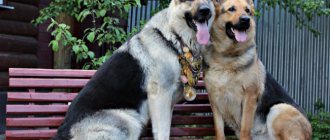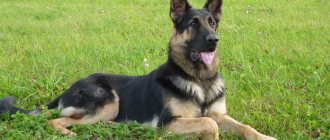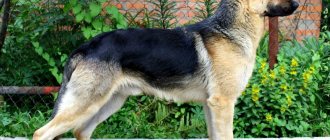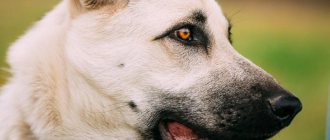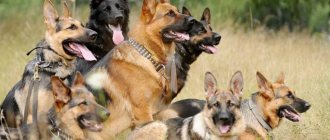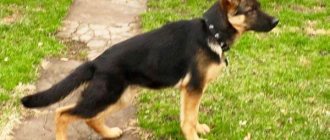The popularity of German shepherds all over the world has led to the desire of breeders to create new breeds of dogs based on them, which would have the best character and exterior traits of the “Germans”.
This is how German Shepherds appeared, belonging to different breeding lines and a large number of mixed breeds. Next, you can clearly see what different German Shepherd mixes look like.
The history of the origin of both breeds - the difference
The East European Shepherd and German Shepherd are similar in appearance, but differ in character and temperament. They have different origins and breeding purposes.
East European and German Shepherd
Story one
Breeding our own type of dog began with the search for four-legged animals suitable for the main breeding material base. To obtain large dogs with good working qualities, European shepherd dogs were chosen. Planned selection was necessary - the main breed is not suitable for living in the harsh climatic conditions of the North.
Over the course of four decades, work was carried out, resulting in the creation of a separate type of shepherd dog with improved physical and service qualities. In 1964, the Canine Council of the Ministry of Agriculture adopted a new type called the "East European Shepherd Dog".
Story two
The origin of the Germans begins with shepherd dogs who lived in Germany. Animals were improved by breeders who sought to obtain dogs:
- able to interact with people;
- protecting animals;
- capable of managing livestock.
At first they were planned to be used as shepherds, but over time this function faded into the background. As a result, law enforcement agencies became interested in promising pets: police and military departments began working with representatives of the subspecies because of their physical strength, obedience and training abilities.
Main differences
If you compare German and Eastern European breeds, you can immediately notice the differences between one and the other. Visually, it can be determined that VEO is significantly heavier and larger compared to the German representatives. This difference primarily affects the endurance and speed of the animal, as well as performance.
For example, if we compare shepherd dogs according to these characteristics, then the German shepherd differs from the Eastern European one and can give a head start when working on the scent for a long time, but the VEO, on the contrary, is considered faster over long distances and high speeds than the German one.
Among other things, Germans are considered noisier and more active. Another difference between these pets is that Eastern European dogs mature relatively late.
Despite certain differences, these two varieties are currently extremely popular, which is explained, first of all, by the fact that both of these breeds differ from all others in their excellent character, versatility, intelligence and ability to train.
Character and training
The main differences between the Veo and the German Shepherd are not only in appearance, but also in character traits. Representatives of these two popular species have completely different temperaments, as well as perceptions and attitudes towards the training process.
Since the Germans were bred specifically for herding purposes, these dogs were instilled exclusively with appropriate habits. These dogs are distinguished by very good endurance, mobility, the ability to keep track for a long time and run quite long distances. Puppies of this species will be ideal friends for any hyperactive child or person who plays vigorous sports or leads an active lifestyle.
As for training these pets, Germans are highly trainable and perceive the process as an interesting game. It is thanks to this that many representatives of the breed reach great heights, even in the most complex and professional training.
As for the Eastern European species, these dogs are distinguished by their endurance and calmness. At the same time, the relatively less energetic and balanced Veos are perfect for guarding and living with a person leading a moderate lifestyle. Currently, Veos are preferred for service in the border troops, and these dogs are also chosen as guide dogs, since, among other things, they are also distinguished by their stable psyche.
If we compare which shepherd is better, German or Eastern European, in relation to people, then in this matter the difference between them is completely invisible. Both of these dogs are very friendly to all people around them. Training a Veo is also not difficult, but unlike the Germans, they perceive the training process not as a game, but as a real and responsible job. Therefore, even an inexperienced breeder can raise a veo.
Despite the fact that these two varieties have certain similarities, German ones are still preferred for performances in competitions. This is explained, first of all, by the fact that Eastern Europeans have a more phlegmatic and calm character.
Comparing the Eastern European and German in character, it is quite problematic to say exactly which of them is better, one or the other, since each person chooses a pet based on his individual preferences.
Are there large external differences between the two breeds?
The difference between the German and East European Shepherd is considered to be this feature: the latter is famous for its massive physique and height, which exceeds the norm of the former by 10 cm.
The main differences include the nuances of body structure:
- lack of back tilt in Easterners;
- European Shepherds have long forelimbs and shorter hind limbs.
Important! Each subspecies has a different type of movement. Purebred Europeans move at a measured and free trot, while Easterners move at a fast and sweeping gait.
Dog color
The coat color of both representatives is individual:
| VEO | BUT |
| shabby, on a lightened background – mask | zonal |
| black | black and tan |
| deep black, closer to black and tan | black |
| zonal gray | black-and-white |
| zone-red |
Important! Germans have a more saturated color; any changes in color are due to defects.
Dog temperaments
The character of Orientals is calmer; the dog is known for its slowness and easy assimilation of the basics of training. Likes to “forget” some of the completed elements. For this breed, the retention program refers to work that is done with the highest quality. At this moment, the animals do not have anger or rage; they easily track the movements of the detainee’s hands and intercept the limb in which the dangerous object is located. The balanced nature of Eastern Europeans does not allow them to break down, but they easily bring their owner to this state.
What makes European Shepherds different is their mobility, agility and speed. Activity causes many problems in learning. Dogs easily get into a rage; they are torn away from violators with difficulty. Animals are easier to train, but they can throw tantrums and reach psychological breakdowns. Dogs are versatile species that require an owner who knows exactly what he wants to get from them.
Important! Teenagers can easily cope with training East European Shepherds, which cannot be said about their German relatives. The latter periodically needs to indicate who is the dominant link.
German Shepherd in pursuit
Types of "Germans"
Representatives of this breed can be short-haired or long-haired. In the first species the coat is thick and hard, on the tail, neck and hind legs it is softer and longer, the undercoat lies tightly to the body, in the second the coat is long, soft, slightly wavy, the undercoat is weakly expressed.
German Shepherds are also divided into species according to breeding line:
- exhibition - purebred individuals with an exterior as close as possible to the standard;
- working – have a denser and squat build;
- Shepherd dogs of East Germany are heavy, strong dogs with a massive body and a large head;
- American – these dogs are taller than their German relatives and have an angular build;
- Czech – outwardly they look like shepherd dogs from East Germany, but have a more docile and calm character;
- Belarusian Shepherds are strong and hardy dogs with dark or spotted hair, obtained by crossing German and Central Asian Shepherds and Russian Laikas;
- British - they are characterized by a long, stocky body and short legs.
In addition, as a result of breeding work on crossing German shepherds with other animals, such breed varieties as the Czech Wolfhound, American Shilohound, Dutch Sarlouz Wulfhound, and English Utonogan were obtained.
Who is more picky about feeding?
Dog handlers advise feeding large dogs with high-quality industrial food, starting from premium food. Dogs can also eat natural food, which is based on animal protein. In the territory of the former USSR, owners of four-legged animals often prefer self-prepared food. However, the main problem with such a diet is the lack of vitamins and minerals necessary for the normal functioning of the body.
Large dogs often suffer from musculoskeletal problems during their active growth phase or in old age. This leads to the need to include soft cartilage and chondroprotectors in the menu - drugs that activate the development of cartilage cells.
Important! Both dogs are not picky about feeding. A balanced diet with a sufficient amount of nutrients is a suitable option for feeding four-legged animals.
Barks - wants to attract attention
Barking is a way of attracting the owner's attention. If you don’t walk together much, she wants to go out. Often, owners take their pets out for 15-20 minutes, but this is not enough for the dog; it waits for hours before the next walk.
If a dog barks with its tail between its legs (a sign of fear), the explanation is simple - it knows the degree of punishment for incontinence, if you react with a shout or punishment. But she will continue to bark, wanting to get what she needs.
A dog barks when he is left alone for a long time, suffering from loneliness. In the evening, the family gathers at home and pays special attention. The dog experiences discomfort when the moment of a new separation comes.
What is the difference between a German puppy and an Eastern European one?
Babies can be distinguished by a characteristic feature - the line of the back. In Germans it is slightly inclined towards the tail, in Eastern Europeans there is a perfectly straight line between the withers and croup. Second babies are born larger and are able to gain weight faster. Easterners are slower and clumsier.
Important! It is impossible to predict which purebred dog will become the future champion. Puppies of different classes are born in a litter.
East European Shepherd puppies
What to feed the young "Eastern"
It's no secret that proper nutrition helps dogs avoid many diseases.
The basis of food for shepherd dogs is fresh meat (chicken, beef) and cottage cheese. Meat can be easily replaced with boiled fish.
Also, the puppy’s diet should include chicken eggs, vegetables, soups, cereals, and special vitamin supplements. You should not give your young shepherd food too thick or hot. It is highly undesirable to overfeed your pet.
For an adult dog, store-bought food may be suitable.
Which shepherd is better, according to dog handlers?
Both types are equally valuable, especially when it comes to their performance qualities. Both representatives are characterized by:
- poise;
- obedience;
- quick learner;
- absence of attempts to dominate a person;
- distrustful attitude towards strangers;
- guard and security skills.
But the German representatives were originally intended for grazing livestock, so they are characterized by liveliness and mobility. The difference in the type of temperament plays a big role:
- BUT choleric from birth;
- Easterners are a mixture of sanguine and phlegmatic, known for being less active and more balanced.
Important! Eastern European dogs have a more complex character. Constant wariness of strangers can develop into mistrust or outright anger.
Both species learn well and have high intelligence. The main difference lies in the following points:
- Character - Easterners are more reasonable, they perceive classes as work. For the Germans, teams are a game of chance; they love to set records and improve their performance in every training session.
- Psychotype - the German-European grows up faster, while its competitor remains a baby until almost 2-3 years of age.
- Learning speed - European dogs quickly learn material, learn complex elements and completely obey. Easterners prefer to work more slowly, they need more time to understand commands, and they are often stubborn.
Important! Long-term training shows that NO is losing to Eastern Europeans. The former are prone to hysterics when overworked. The latter work tirelessly and are well aware that training is more important than their own desires.
An important feature is its working qualities. The Germans are famous for their flexibility, suitable for sports and official disciplines. For Easterners, skills other than security are difficult to master.
German Shepherd puppy
With a long pursuit, the BUT wins - they can follow the tracks for 2-4 hours and not get tired. The second representatives stop racing within an hour. Sports disciplines are one of the advantages of dogs from Europe - they perform spectacularly and easily master tricks of any complexity. The latter pass all obstacles more slowly, without recklessness.
Important! The only thing in which the BUT loses is the service as a guide. Increased emotionality is a bad idea for working as a nanny.
Education and training
Commands for initial study:
- "It is forbidden";
- "Sit";
- "Lie";
- "Place";
- "To me";
- "Near".
These are the basics thanks to which you can calmly walk and guide your baby at home. You will have to be patient and demanding. Explain several times what you want, show it yourself, for example: give the command “sit” by showing a piece of the prepared treat, sit him down yourself, lightly pressing on the sacrum, after he sits down, give him the treat.
Then repeat the whole process again, as soon as he understands and sits on his own - praise not only with a piece, but also with an affectionate word, say “Well done” or “Yes” and hold him by the withers, you can pat him a little on the sides. They love it very much when the owner is happy and expresses his approval, so next time he will try to earn praise as soon as possible.
In addition, pay attention to his physical activity; walking will be required: 2 times a day for an adult pet, and puppies are supposed to walk 4-5 times a day, after each meal. You need to play with them, run, explore new routes and give them time to explore the outside world
Make sure that he doesn’t pick up any dirt, especially bones and unpleasant debris; kids love to do this.
In terms of learning, East European Shepherds are solid good students. They are smart, willingly delve into the essence of the actions explained to them and do not confuse reality with the situations simulated by the dog handler on the training ground. VEOs easily deal with basic OKD commands and learn the basics of ZKS with no less enthusiasm, but this is not the breed that masters the material once and for all.
As dog handlers like to say: the East European Shepherd learns and trains throughout its life. This is the only way to really control the animal and not have to fear for the safety of others. Accordingly, when introducing such a brutal pet into your home, you need to be prepared for the fact that training and repetition of the material covered will become an integral part of your life.
We suggest you read why your cat’s breath smells like rot: reasons and what to do
Important: the East European Shepherd considers its owner not the one who brings him a bowl of food every day, but the person who trains it, so it is better to train the pet on your own, consulting a professional dog handler only in the most difficult situations. At this age, the baby will have to learn a new rule: before performing an action, you must obtain the owner’s permission
By the way, it is possible to fully train a shepherd dog only if it understands and recognizes the authority of the owner. When playing with your VEO puppy, do not let him win. The baby regards this behavior as a weakness that he will not hesitate to take advantage of.
At this age, the baby will have to learn a new rule: before performing an action, it is necessary to obtain the owner’s permission. By the way, it is possible to fully train a shepherd dog only if it understands and recognizes the authority of the owner. When playing with your VEO puppy, do not let him win. The baby regards this behavior as a weakness that he will not hesitate to take advantage of.
The age of 4 months is the optimal period for learning more complex commands from the same OKD with the East European Shepherd. If everything is planned correctly, by 6 months the puppy will be ready to pass the course standards and will be able to begin engaging in security activities. True, up to a year, the skills and abilities acquired by the pet will have to be further honed and brought to perfection. As noted earlier, repetition of material for the breed is an urgent need.
For owners planning a sports career for their pets, we can recommend the international IPO course. However, it is worth understanding that such programs from the impressive and, what’s more, heavy “Easterners” go through with difficulty. As for the ZKS, it makes sense to enroll an East European Shepherd in such courses after it has successfully completed the OKD, and also if you are a law enforcement officer and work in tandem with a four-legged friend.
Which breed should you choose?
It is difficult to choose a suitable dog; it is necessary to take into account the personal attitude of the four-legged dog towards humans, children and other pets. Despite the balance, plasticity of the nervous system and active defensive reflexes inherent in both representatives, there is a significant difference in behavior:
- BUT - more friendly, less wary of strangers.
- VEO - they combine protective qualities with aggressive behavior; without correcting their behavior, they can consider any stranger an enemy and test the sharpness of their teeth on him.
Both species do not have pronounced aggression towards children, but Eastern European dogs are more forgiving. They will not recognize the authority of the younger family member and refuse to obey his commands. The Germans automatically perceive him and raise him one step higher in the hierarchy.
BUT it gets along easier with other pets. Easterners love to abuse domestic animals, and are capable of killing street animals. Each dog is suitable for a specific person; the search is carried out on an individual basis. Dog handlers believe that the German is more suitable:
- people leading a sports lifestyle;
- for lovers of tourism, hiking, and outings;
- large families with children;
- living in city apartments.
It is recommended to have Eastern European representatives:
- people who have a tight work schedule;
- those who like to spend their free time at home;
- representatives of the older generation;
- those who do not have children or other pets;
- lonely;
- those living in private houses with a sufficient garden plot - the dog will be uncomfortable in the apartment, he will begin to suffer from the lack of space.
Important! These recommendations are considered general; the future owner must choose a suitable dog for himself. Foreign shepherd dogs are more suitable for the role of a companion; Eastern European ones are taken for official needs.
What does a cross between these breeds look like?
The common roots of the two representatives allow mestizos to obtain a successful combination of qualities. Mixed blood leads to the appearance of a large, harmoniously built dog with a hard coat with a thick undercoat.
Dogs grow up to 70 cm, maximum weight is 60 kg. From their parents, babies inherit:
- high level of intelligence;
- calm;
- self confidence;
- ease of training;
- excellent watchdog and security qualities.
Dogs get along well in a large family with other pets and children. They treat strangers with distrust, but they do not show aggression without reason. Animals perfectly cope with the role of protector and watchman, do not get lost and quickly make decisions.
Important! Future owners of the half-breed must remember that lack of training will lead to the dominance of the most unpleasant character traits of the East European Shepherd.
The dog needs to be trained from the moment it appears in the house, and at an older age, attend OKD courses with it.
Before purchasing one of the representatives of related species, you need to study the basic characteristics and ability to live in a private house or city apartment. In small-sized housing, the Easterner will begin to look for personal space, driving both pets and owners out of the place they like. A suitable place for him is a spacious enclosure with a well-insulated booth.
Before choosing one of the breeds, it is worth studying all their features, as well as your character and the ability to create suitable conditions for your pet.
How the German Shepherd differs from the East European is easy to figure out if you know the initial characteristics of the two breeds. Outwardly, these are similar dogs, but with special typical exterior characteristics.
Each breed has its own history of formation, distinctive features in character and appearance. Similar service qualities, somewhat different between them. We have collected 10 differences and features.
The history of the origin of both breeds - the difference
The East European Shepherd and the German Shepherd were bred at different times.
- German Shepherd: 1955, country Germany. Use: herding dog, service representative with excellent characteristics. Bred, participated in search activities, was used during hostilities, and deservedly received the title of “best service breed.”
- VEO: country of the USSR, 1940. The representative is distinguished by improved performance characteristics and can work in difficult climatic conditions. In the blood of the European representative there are Germans, Caucasians, Laikas. A larger and more powerful dog, it was used for service on the border, participated in rescue operations, and performed the duties of a “demolition dog” in wartime.
Story two
Now let’s return to the East European Shepherd and remember the development of cynology in the USSR. In those days, breeders faced a serious task - they needed to breed the same breeds of dogs, or similar in performance characteristics, as in European countries, but adapted to living conditions in the Soviet Union. We owe this period of history to the appearance of many interesting and beloved varieties of pets that we love today.
The thirties were not easy, hunger and poverty reigned in the homes of ordinary citizens, many came under suspicion of anti-Soviet actions, and others crossed the line of the law in an attempt to find a way to live better. The prisons were overcrowded and reliable guards were needed for guard duty. VEOs were also used for service in border areas. The creation of a new breed based on existing German Shepherds is due to several reasons:
- Taking into account the climatic characteristics of Siberia and other regions with a difficult climate, a more hardy, stronger dog than NO was required.
- The honor of the country forced us to create, not repeat. In addition, everything produced in the USSR was obliged to surpass in its characteristics everything foreign.
- VEOs have become more universal, as the range of responsibilities and work they perform has been significantly expanded.
The result was a beast that could satisfy absolutely everyone, from military services to ordinary people in need of help from our least friends.
In peacetime, the dog copes well with the duties of a guide, companion and simply a favorite of the whole family.
Exterior differences between two shepherd dogs
It's quite easy to tell the two dogs apart. VEO – larger, wider with a straight back line, long paws, tall. Differences in height at the withers, about 10 - 12 cm. Eastern European females correspond in size to German males.
- Weight differences: the German is 10 - 15 kg lighter.
- The German Shepherd is the owner of a bright inclination of the spin line by 20 - 25 degrees. Eastern Europeans do not have such a slope.
- The chest of the Eastern European is wider and deeper, the paws are larger and wider, and heavier. The movements are wide and sweeping, strong and quick pushes from the support. German - moving at a trot.
- Colors: Europeans have more quantity and variety in acceptable standards. It can be red, zonal, zonal-gray, black-gray. German representative according to the standard: the owner of a clear mask on the face, black and gray-zoned in color.
What about the wool?
Some people believe that there is a long-haired variety of Shepherd. There is no such variety. The fur length of the Eastern European stern guards cannot be too long - this is regarded as a flaw.
It is worth describing the dog's fur:
- The coat is thick and quite hard to the touch.
- The guard coat is not too long and lacks waviness.
- The undercoat looks rich and is quite soft to the touch.
- As a rule, the undercoat is lighter than the guard hair.
Shepherd dogs of the Eastern European type are most often black and gray in color. Black and black-and-red dogs look interesting.
Differences between the German Shepherd and the Eastern European in behavior
East European and German Shepherds have different characters, with their own individual behavioral characteristics.
- Germans are ideal in obedience, active and more emotional. They will be loyal and devoted friends to the owner and all family members. They are perfect for family keeping, good-natured and patient with children. Can live with other pets.
In training and the education process, they are flexible and efficient. They have increased endurance, covering significant distances without rest. Like a dog - a shepherd in the past, independent, attentive. She does not show aggression towards strangers, she is wary, but friendly. A striking feature is devotion and lack of fear of danger; he considers working with his owner to be the best reward.
- Veo is calmer, emotionally stable, patient and reasonable. Shows high security qualities. The missal is ideal for serving for the benefit of the homeland. He is tolerant of strangers, but is in a hurry to come into contact with them, prefers loneliness or the company of the owner and family. It takes a long time to get used to new people, and is not trusting and wary.
Education and training begin from the very early process of socialization; the pet matures quite late. Loves a measured life, tranquility. The upbringing process is different and will require more training time. It does not experience natural excitement, unlike its German counterpart.
Good family friends, obedient, without sudden mood swings. He is well versed in facial expressions and changes in tone of voice. Prefers to wait and watch, and takes action at the owner’s command - immediately. Fearless and confident.
The difference in temperament and characteristic behavior in both breeds is striking, they are both obedient and focused on the person-pet relationship, they train well, but the Germans are more active and passionate, while the European is calm and reserved.
Features of keeping shepherd dogs
No matter how they are kept, shepherd dogs need daily physical activity. These could be evening and morning walks lasting at least an hour each or training sessions.
Caring for the "Eastern European"
Despite its size, VEO is suitable for keeping in an apartment, as it has a calm character and intelligence. She can also live outside in an enclosure. But although this breed can tolerate severe frosts and heat, in inclement weather it must be taken to a warm room.
When keeping an East European Shepherd in an apartment, it should have its own corner with bedding.
The pet needs to be combed at least twice a week, and more often during the molting period (autumn, spring). Other hygiene procedures (cleaning ears and eyes, trimming nails, caring for teeth) are carried out as usual. It is recommended to wash shepherd dogs only when necessary and with a special shampoo, preferably protein-based. You can feed them natural food specially prepared for the dog, or ready-made food for large breeds.
Training and education should begin as early as possible in order to properly socialize the pet and help it become a real guard and protector of your family.
Table: approximate plan for working with an East European Shepherd puppy
| Age | Skills and Commands Learned |
| 1 month | At the age of one month, the babies live with a breeder who begins to accustom the dogs to communicate with people and wear a collar and leash. |
| 2–3 months | When a young shepherd dog gets a new owner, he must teach the baby to respond to a nickname, go to the litter box, and obey during walks. He must be taught to carry out the simplest commands: “Come to me!”, “Ugh!”, “Place!”, “Teeth!”, “Voice!” |
| 4–6 months | Up to six months, a young dog is taught to take barriers, walk up the stairs, follow the commands: “Near!”, “Sit!”, “Lie down!”, “Stand!”, “Fetch!”, “Give!”, “Barrier!”, "Forward!". |
| 6–8 months | During this period, the pet is taught to find hidden things by smell, guard objects, pursue and detain violators. Such commands should be taught to the dog by an experienced trainer. From 6 months the dog is taught to wear a muzzle. |
| 1.5 years | The VEO puppy takes the OKD course (general training course) and can study guard, guard or protective-search service |
Video: East European Shepherds at an exhibition
Caring for the “German”
The basic rules for caring for both shepherds are the same. There are differences in training, as dogs differ in temperament:
- VEOs are slower. They learn commands well, but may not want to carry out any element due to stubbornness or laziness. The “Germans” are very active and carry out all tasks with great pleasure.
- During training, the “German” can get too carried away; you need to be able to stop him in time. This rule especially applies to detention training. VEO feels the boundaries of what is permitted, she is not subject to psychological breakdowns.
- VEO training can also be carried out by a teenager under the guidance of a trainer; a “German” should be raised by a strong-willed person who is physically strong.
Breeds in modern times
In the modern world, the service qualities of shepherd dogs, as well as their character and high ability to learn, are highly valued. Germans are popular all over the world, they are actively bred and all breed characteristics are supported. There are clubs and nurseries anywhere in the world, the cost is quite stable and depends on various indicators.
Veo - unfortunately not recognized by the cynological federation, has no official standard and is widespread mostly in the Russian Federation and the countries of the former CIS. That does not prevent her from serving on the border, living with families and feeling great next to a person.
Barks because he is afraid
A puppy or adult dog tucks its tail and barks - a person or object scares them. Do not scold the dog for barking like that, show the pet that “this” is not scary and does not pose a threat. The pet is wary of strangers - give people the opportunity to hand-feed the girl and show friendliness. Convince the dog that fears are only apparent.
If your pet is afraid of other dogs, take him to group classes and introduce him to his fellow dogs on walks. Make sure that potential canine friends do not show aggression. Convince your pet that his fears are futile. Show love and care, don’t be nervous, don’t freak out, dogs are sensitive to such emotions.
Veo or German, who to choose?
Both dogs are perfectly manageable with ideal service characteristics and behavior in general. Both have decent character, without excessive aggression, aimed at interacting with people.
Caring for both breeds is identical, including: proper and balanced nutrition, grooming, hygiene, physical activity, education and training, as well as a vaccination regime.
HO and VEO adapt well to different climatic conditions, but Eastern Europeans are more inclined to live in cold climates. They can live both in a house and in an apartment and in enclosure conditions.
But - it is suitable for more active people, athletes, young families, singles. Veo - for a more family-friendly lifestyle and a relaxed lifestyle, although it is larger than BUT.
Both pets require sufficient physical activity, a constant educational process, and a person with a strong character who can provide proper maintenance.
Price for a puppy VEO and BUT
Germans are more common around the world and are officially recognized, the price will be slightly higher.
- Average cost: from 30 to 60 thousand rubles.
The cost of a puppy consists of many indicators: the title of the parents, individuality and exterior appearance. Performance characteristics will also be taken into account.
- The average price of Veo puppies is from 20 to 35 thousand.
join the discussion
Share with your friends
Mestizos are often found in nature, both among people and animals. Mixing two different breeds of the same species can be accidental or deliberate so that the litter receives certain qualities. For example, a cross between a wolf and a shepherd can produce strong and hardy offspring, however, they can be wild and aggressive.
In history, there are examples of crosses between German Shepherds and Rottweilers, Great Danes, Siberian and Caucasian Shepherds, Samoyeds, Golden Retrievers, Dachshunds and many other breeds. There have been cases when repeated mixing of breeds led to the appearance of a new one. However, mestizos are not always recognized by national cynological communities.
Differences up to one month of age
If anyone who has ever encountered pedigree dogs of this group can already distinguish a shepherd from a mongrel at the age of 5-6 months, then not everyone will be able to make the right choice at the age of 3-4 weeks. What should you pay attention to at such a tender age?
Mom and Dad
Never buy a puppy without making sure that its parents correspond to the breed characteristics of the German Shepherd. The best evidence in this case is the correct documents for the parents and the children themselves.
To reassure yourself, you should call the club and find out if mom and dad are registered there.
Attention! The club may refuse permission to breed if one of the parents has hip dysplasia.
This is a hereditary disease (genetic predisposition), the symptoms of which may appear only at 6-12 months of age: lameness, increased fatigue, joint pain, unsteadiness of gait, X-shaped stance of the hind limbs.
Hip dysplasia is a real scourge of large breed dogs (which includes the German Shepherd). Treatment is long, painful and not always effective.
Brand
Confirmation of documents is a mark on the inside of the hind paw of both the parents and the puppy itself. Plus the metric, of course.
The stamped mark and the information about it in the metric must match!
If the baby does not have a mark, then, most likely, the mating was “left-handed”; the club did not give permission for it. Such a puppy can be purchased as a pet - this is a real shepherd dog, which has received breed characteristics from its parents, both in appearance and psyche, but the path to the ring will be closed to it.
general characteristics
Metis is the offspring obtained by crossing two or more breeds. Such offspring, as a rule, are superior to their parents in some respects. For example, it becomes stronger, more resilient, less susceptible to diseases, less aggressive, and so on. It is also characteristic of crossbreeds that they produce offspring both among themselves and with other breeds. Most often, the appearance of mestizos occurs as a result of human intervention, with purposeful experiments on animals.
The resulting dog has traits from both of its parents, but their combination often allows you to get even a new breed. Mixing of dog species can also occur randomly, especially with mongrels or those dogs that are outdoors without proper supervision.
Why do you get a hybrid of a husky and a shepherd?
Crossbreeding is a method of obtaining crossbreeds that have good health, the absence of genetically inherited diseases, and advantages in appearance. If hybrids have been bred over several years, their appearance is officially documented, and sometimes they are registered as a new breed.
In the case of the German dog and the husky, scientists set themselves the task of obtaining a hybrid capable of working in harsh arctic conditions. The designer dog was supposed to not only transport cargo, but also participate in rescue and search operations during snow storms, blizzards and blizzards. American breeders were involved in crossing husky and shepherd breeds. They managed to breed a stately, handsome mestizo with high intelligence, capable of working in northern climates. Unfortunately, he is not as hardy as the Hasyata and does not obey his owner unquestioningly like a German dog, but his character and characteristics are used in modern life.
Types of crossbreeds and their descriptions
One example of crossbreeds is a crossbreed between a Caucasian and a Central Asian Shepherd . Many believe that these two breeds are closely related, which is manifested by the presence of similar features in appearance and behavior. However, dog breeders use representatives of these species to produce strong and strong puppies. Children from such “marriages” turn out to be massive, powerful, and their appearance is more similar to the Caucasian Shepherd Dog.
Puppies have thick and strong muscular legs, a long and bushy tail, which is often docked. The coat is thick, long, with a good undercoat layer, forms a “collar” around the head, and covers the rest of the body more evenly. It comes in the following colors: white, dark brown, gray, red or beige.
Stafford and German Shepherd hybrids are distinguished by their unpredictable nature, high fighting skills, increased aggressiveness and stubbornness. At the same time, they are medium to large sized dogs, similar in appearance to the Staffordshire Terrier. The coat is usually short and does not cause any problems for owners. It is not recommended to have such dogs if there are children in the house.
St. Bernard and Shepherd mixes are not so common, but this does not mean that they are not popular. These are large dogs with a somewhat intimidating appearance, however, by nature the dogs are calm, balanced, and stress-resistant. Such dogs are excellent protectors and guards, as well as simply loyal friends.
Puppies from Chihuahuas and German Shepherds grow into small dogs; rather, they can be classified as small (if the Shepherd genes predominate, then the growth is slightly higher). Such dogs feel great in apartment conditions, love to play, are sociable, smart and obedient.
Crossing a Pitbull with a German female produces some pretty cute puppies. They are characterized by calmness and pronounced protective properties. Most often, the coat color is brown, there may be black spots, and the dogs have dark eyes.
The “marriage” of a boxer and a German woman gives birth to cute, medium-sized puppies that love children, are distinguished by their friendliness and high watchdog properties. However, such dogs can be stubborn.
Malamutes, when mixed with Huskies and German Shepherds, produce unusual offspring. In appearance, the mestizo can be mistaken for a wolf, however, the dog is not at all as dangerous as it might seem. These dogs are friendly and get along well with children; their character is calm and balanced.
The Rottweiler can also be crossed with a German. The offspring are characterized by the following features: they are large animals, characterized by curiosity, calmness, activity and mobility, and self-confidence. Such dogs may show attempts to dominate the house in relation to other animals and even their owners. The dog performs protective and security work well.
Hybrids of the West Siberian husky and shepherd dog are large and hardy animals, capable of performing various tasks, including the role of a sled dog. These are very loyal pets to their owner, with a keen sense of smell and hearing. Among the disadvantages of dogs, it can be noted that they can run away, do not obey well, are wayward and have little tendency to learn.
A cross between a Belgian (Malinois) and a German Shepherd is well suited for military service. They are often red in color and somewhat smaller in size than the German, which they also resemble in character. These are hardy animals that can quickly develop running speed. Therefore, they are highly valued in police services.
Doberman and German mixed breeds have certain negative aspects. For example, they do not tolerate loneliness well, need high physical activity, react poorly to other animals in “their” territory, and have an aggressive appearance. However, there are also a lot of positive aspects: dogs get along with children, are quite calm and intelligent, are easy to train, are obedient, and do not show unreasonable aggressiveness. Such mestizos have high guard and protective potential.
Maintenance and care
For a typical city apartment, the East European Shepherd is not the most suitable size, so if you have already decided to add to the family, think in advance about how to provide the dog with a sufficient amount of free space. In particular, the pet's bed should be in a secluded but well-lit place - the breed does not need rickets. If the shepherd's mattress lies in the aisle, where the feet of household members are constantly clinging to it, this irritates and unnerves the puppy. It is better to choose a semi-rigid mattress for the East European Shepherd to avoid the appearance of calluses on the elbows, and fix the food bowl on an adjustable tripod (choose the highest design), which will reduce the load on the joints.
The optimal option from the point of view of convenience for the owner is to keep the East European Shepherd in an enclosure with an insulated kennel, which should be of such a size that the dog can not only lie down in it, but also stretch out its paws. Dry hay is suitable as bedding. The main thing is to remember to change the bedding in a timely manner and treat the dog’s home for parasites twice a year. Usually, a signal that it’s time to disinfect is the shepherd’s reluctance to lie in the kennel. In the summer, VEO’s hay “bed” is not needed, but to prevent your pet from developing elbow calluses, it is better to lay a rug in the enclosure. And most importantly: no chains, even if they are long and allow the dog to run all over the yard. This approach spoils the animal, developing in it distrust of the owner and anger against the whole world.
Hygiene
To make your life easier in the future, teach your puppy the idea of hygiene as a necessity that is inevitable. Remember, an East European Shepherd is not a Pomeranian that can be immobilized with one hand. And if a pet resists hygiene procedures from an early age, then when the animal matures and gains muscle mass, it will be impossible to “persuad” it. Otherwise, the breed is considered unpretentious and does not require professional care. For example, daily brushing of VEO will be required twice a year, during the shedding season. In the intervals between these periods, dead hairs are removed once or twice a week with a brush or rubber mitten. It is recommended to wash your East European Shepherd twice a month if the animal does not run through puddles. In summer, you can limit yourself to swimming in open water, which the breed absolutely loves.
It is better to examine your dog’s ears regularly, but there is no point in fighting for complete “sterility” of the ear canal. Remove brown plaque with wipes and veterinary lotions only when there is really a lot of it accumulated. Remember, frequent “diving” of cotton swabs into the ear funnel provokes sulfur secretion, which makes the ear look even more untidy. By the way, it is better not to pet East European Shepherds on the head until they are one year old. The breed’s ear tissue is heavy, slow and difficult to “stand up”, so any careless touch to it can cause incorrect placement of the cartilage.
Walking and physical activity
East European Shepherds are active and strong dogs, although they are inferior to their German relatives in endurance. Accordingly, they should be less stressed during training and walks than German shepherds. For example, until the age of 7-8 months, a VEO puppy is prohibited from any physical activity. The only thing your baby can count on is short excursions in the park and swimming in rivers and lakes if the weather is warm enough. Puppies are also not allowed any harnesses with weights, although such accessories are not prohibited and can be a good help in training a service dog.
Traditional walks on a leash are not practiced with adults. If a mature “Eastern” has already gone out into the street, he should be allowed to let off steam. Typically, the breed needs 1-2 hours to warm up, which can include towing objects in the snow or sand, racing behind a bicycle, jogging in shallow water and swimming. But all this is provided that the pet is healthy. For sick and cold dogs, any sports, including water sports, are strictly contraindicated. In addition, in the first year of life, it is better not to offer jumping exercises to your East European Shepherd. Like any large breed, such exercises are difficult for VEO, which only accelerates wear and tear on the joints.
Feeding
The East European Shepherd does not require a specific diet. She will be satisfied with a traditional dog menu or premium industrial food. However, it is better to follow a number of simple rules to keep your pet healthy.
- Meat is given raw if it is fresh and you are aware of its origin. In other cases, it is better not to risk it and boil or scald the product.
- No food from your table, even if the pet asks.
- Less fruits and vegetables in your diet. Yes, they contain a lot of vitamins and healthy fiber, but the digestive system of the East European Shepherd is poorly suited for digesting plant foods.
- Dogs do not need any “tasting” additives. In particular, porridge from several types of cereals, nuts and dried fruits are unnecessary excesses that are not worth spending time and money on.
It is almost impossible to properly balance the natural diet of an East European Shepherd at home, so all kinds of supplements and veterinary dietary supplements come to the rescue. For example, VEO puppies are given complexes with chondroitin and glucosamine to support articular cartilage. However, here too it is important not to overdo it: an overdose of minerals and vitamins is a serious thing. First consult with a specialist who will accurately determine whether your ward needs additional feeding or can easily do without it.
Usually puppies move to new owners no earlier than two months of age. This is exactly the period when the baby is transferred to five feedings a day. From 4 to 8 months of life, the East European Shepherd eats four times a day, from 8 months to a year - three times. It is recommended to switch the “Eastern” to two meals a day from the age of one and a half years, but even such individuals are given a light kefir or fruit and vegetable snack in the middle of the day for the first 5-7 months.
How to choose?
When buying a dog, it is always important to remember that it is not only a “want”, but also a responsibility for the life of another creature. It is easier to start communicating with a dog when it is still a puppy. In this case, the owner will be able to become a full-fledged authority and raise exactly the kind of pet he needs. You need to understand that a dog requires attention and certain investments. This includes time, emotions, activities with the animal, and money (for example, for arranging a sleeping place, food, vaccinations, and so on).
How to choose the right pet is an important question. Before going to the pet store, you should decide what kind of pet you will have: big and small, take into account character traits, coat type (maybe you need a hypoallergenic dog). Then it is advisable to narrow the list to several breeds based on your criteria and study their descriptions and read reviews from other owners. Some buyers dream of purebred pets, while for others this parameter is not so important and preference is given to a crossbreed.
This may be due to the fact that the price of mixed breeds is usually less, while some characteristics are better than the original breeds.
In order to distinguish a crossbreed from a purebred dog, there are “helpers” - international breed standards. They describe what a representative of the subspecies should look like. If there are significant differences, then most likely it is a mestizo. In some dogs, this may be a decrease in the number of teeth or a change in the ratio between the length and height of the body, or a different color. Also, crossbreeds always have the external characteristics of both of their parents. In any case, it is worth consulting with a specialist before purchasing a puppy.
Character traits
Because German Shepherds were originally bred to be herders, they have a very gentle nature. These dogs are kind-hearted, can find a common language with almost any person, easily make friends with children and quickly establish contact with other domestic and farm animals. Training German Shepherds is quite simple. Even a beginner who has no experience in communicating with dogs can cope with raising a representative of this breed. However, training can take a long time, since in most cases an excitable and restless puppy will perceive it as a game.
Europeans are more restrained, calm and reasonable. They make better guards than the “Germans.” While the former get along well with hyperactive people, the latter need a calm owner. Training a European Shepherd is just as easy as training a German, the only difference being that the training will take place in a more relaxed environment. Born servants, these dogs take everything seriously - like work. Due to their phlegmatic nature, VEOs rarely take part in competitions, exhibitions, and games. Cheerful and artistic, restless “Germans” are more suitable for these purposes.
If we talk about the position of these two breeds on the world stage, the difference between them is colossal. The fact is that VEOs are still not recognized by the International Canine Organization. In most cases, you can meet these beautiful dogs only in the countries of the former Soviet Union. Today, it is quite difficult to find a VEO puppy that fully meets the requirements of the breed standards.

